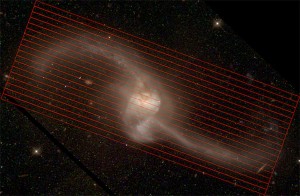main content begins
It achieved first light on the 2.3-metre Bok telescope at the Steward Observatory in Arizona in 2017. Currently existing near-infrared integral-field spectrographs (IFS) typically have very narrow fields of view (FOV) because they are optimized for observations of high-redshift galaxies, which are relatively small in size. By comparison, WIFIS has a 50″ x 20″ FOV.
WIFIS has the unique capability to observe very extended objects in the near-infrared and has an etendue that is comparable to wide-field, optical IFS. Therefore, WIFIS science will be highly complementary to programs carried out by optical IFS, such as CALIFA, SAMI and MaNGA surveys.
WIFIS science includes:
At the University of Toronto, the team working on WIFIS includes Prof. Dae-Sik Moon (PI), Prof. Suresh Sivanandam (Project/Instrument Scientist), Dr. Richard Chou, and graduate students Mark Ma, Elliot Meyer, Miranda Jarvis, Bryn Orth-Lashley, and Max Millar-Blanchaer.
Collaborating institutions include the University of Arizona (Prof. Josh Eisner), Korean Astronomy and Space Science Institute, University of Florida.
For more details regarding sensitivity, optical design and current status, visit Prof. Sivanandam’s WIFIS page.
References:
The wide integral field infrared spectrograph: commissioning results and on-sky performance – Sivanandam, S. et al. 2018.
The development of WIFIS: a wide integral field infrared spectrograph – Sivanandam, S. et al. 2012, Proc. SPIE
The optical design of wide integral field infrared spectrograph – Chou, R. C. Y. et al. 2010, Proc. SPIE
FISICA: the Florida imager slicer for infrared cosmology and astrophysics – Eikenberry, S. et al. 2006, Proc. SPIE

A simulated WIFIS observation of a merging galaxy system. The full WIFIS field is shown with the largest red rectangle. The full field is 50″x20″. The smallest rectangles represent each individual slice of the integral field. The width of each slice is 1.1″.